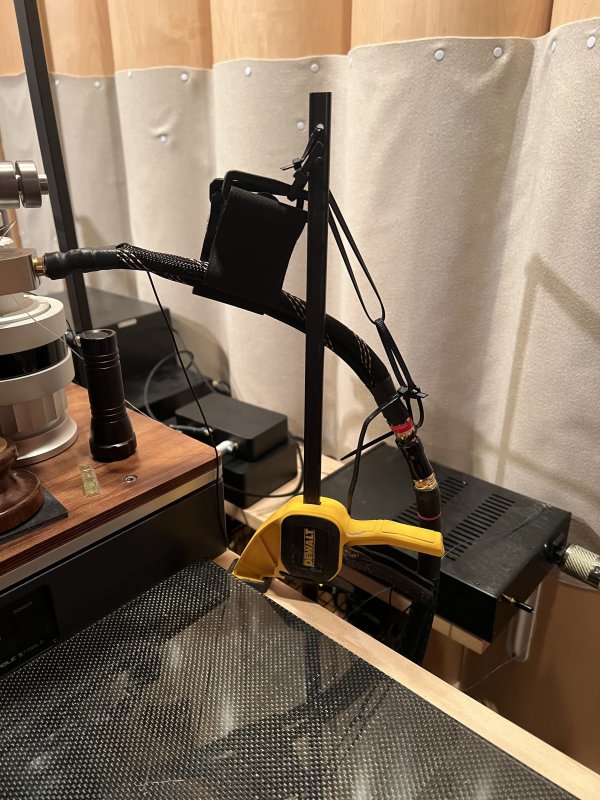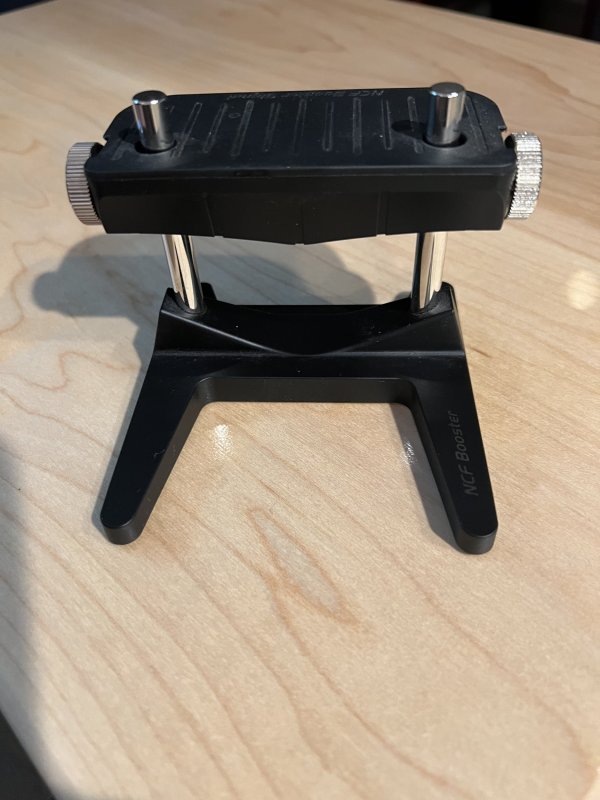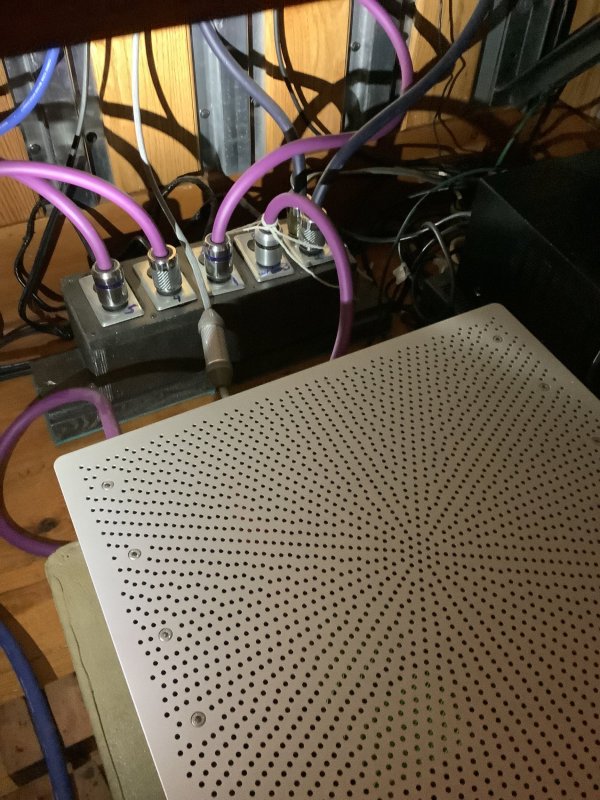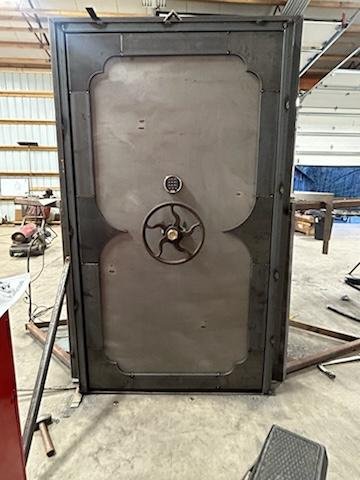Introducing Olympus & Olympus I/O - A new perspective on modern music playback
- Thread starter Taiko Audio
- Start date
You are using an out of date browser. It may not display this or other websites correctly.
You should upgrade or use an alternative browser.
You should upgrade or use an alternative browser.
there are pics on my audiogon system link in my signature, which is normally at the bottom of each of my posts, but does not appear in this thread as it's a Taiko forum. i did just take some quick phone pics see below. standing near the racks they do look ugly, but sitting down they are mostly hidden behind the turntables. so it's not quite as 'sore thumb' as my close ups show. my system pics show the long view to get an idea.Mike, where can I see a picture of your “homemade” solution for holding heavy cables?
Mike Lavigne's System | Virtual Listening Room
mikelavigne's listening room featuring Evolution Acoustics MM7's, darTZeel NHB-468, darTZeel NHB-18NS with 2 internal phono stages., Evolution Acoustics 7.5 meter 'Zeel', Evolution Acoustics 'System' speaker cables--10 feet, WADAX SA Reference DAC, WADAX SA Reference Server with Akasa optical...


Last edited:
I got so tired of cable sagging I went mostly all vertical. I used a variety of slings with cords before this. Then I built this "gang box" each receptacle is walled off inside. Then I mounted it to the floor. IEC end I use a support block that I build according to size of the gap.
Attachments
Christiaan Punter
Well-Known Member
Great report!
Did Chris offer an explanation for why charging a battery supply with different
Power cables would make a difference?
Did you not have time to try the analog out?
A major reason for this is that a power cable does not feed the Olympus server and IO in isolation. It is connected to the power distributor which is, in turn, connected to other components of the system. This couples earth, and potentially introduces a capacitance. Even if the battery-powered components should be almost indifferent, this still has an impact on the rest of the system. Just connecting a power cable to the power distributor alone, even when not connected to a device, can already have an audible impact.No and No.
All I can say is the immersive effect and 3D feeling with the Masterbuilt Ultra PC was a ginormous step up . I passed this on to Chris who will answer
It looks as if my first audition of the analogue board will be when Emile pays his visit here
Mike is spot on: a power cable is a grounding cable, too.
Last edited:
Have you had the liberty to experiment with different metallurgies?A major reason for this is that a power cable does not feed the Olympus server and IO in isolation. It is connected to the power distributor which is, in turn, connected to other components of the system. This couples earth, and potentially introduces a capacitance. Even if the battery-powered components should be almost indifferent, this still has an impact on the rest of the system. Just connecting a power cable to the power distributor alone, even when not connected to a device, can already have an audible impact.
Mike is spot on: a power cable is a grounding cable, too.
I'll take two of them, JT!If anyone needs one of these let me know, it can be modified into an audio rack. Shipping might be a little high! I call it safe and sound!
You will have to give me your shelf config. along with your preferred combination number. 15 numbers and letters! I must tell you its holiday time here in NC so things slow down a bit. Actually its always slow here. Oh another aspect contact our engineer team, we will have to shore your floor up. Its part of the special we have been running. I take it you like the industrial look....A fine choice choosing two Michael, Analog for one and digital in the other... Safe and Sound Appreciates your business!I'll take two of them, JT!
Steve Williams
Site Founder, Site Co-Owner, Administrator
Maybe I can buy one of this to support my MasterBuilt Ultra from the OlympusYou will have to give me your shelf config. along with your preferred combination number. 15 numbers and letters! I must tell you its holiday time here in NC so things slow down a bit. Actually its always slow here. Oh another aspect contact our engineer team, we will have to shore your floor up. Its part of the special we have been running. I take it you like the industrial look....A fine choice choosing two Michael, Analog for one and digital in the other... Safe and Sound Appreciates your business!
@steve williams if you have a little bit of room on the shelf *behind* the Olympus, you may be able to use these Furutech Boosters.
They work well, and you can add sections to the vertical rods to get the correct height range. The set-screws on either side allow one to adjust the platform up/down on said rods.
I have used them behind gear, even reversing them to put the longer end of the feet *under* the component. When in place, they are very secure. I even used one at the duplex outlet to support those massive Sablon King fixtures, which are about the size of John T's safe doors.
They work well, and you can add sections to the vertical rods to get the correct height range. The set-screws on either side allow one to adjust the platform up/down on said rods.
I have used them behind gear, even reversing them to put the longer end of the feet *under* the component. When in place, they are very secure. I even used one at the duplex outlet to support those massive Sablon King fixtures, which are about the size of John T's safe doors.

Steve Williams
Site Founder, Site Co-Owner, Administrator
I really have no room on the shelf behind the Olympus which has limited my options. The big cable came loose again last night even with Christoph's capable hands
...FWIW it looked like you had some room in front (hard to tell depth from pics), which if true, might make a case for moving the Taiko gear forward...to create rear space. Please excuse the arm-chair/remote QB-ing. You'll figure something out.
Steve Williams
Site Founder, Site Co-Owner, Administrator
The Taiko gear is about 165 lbs and is centered on the CMS filter so thanks again but that wont work either
Is there any shelf space under the IEC??? And if there is aprox. inches...The Taiko gear is about 165 lbs and is centered on the CMS filter so thanks again but that wont work either
If there is, a wedge of some sort, small wood block and subsequent thin pieces on top of the wood block until it is firm and level, cardboard folded, anything to keep that support tight under the connection...
Also, get some of the IEC covers mentioned earlier.If there is, a wedge of some sort, small wood block and subsequent thin pieces on top of the wood block until it is firm and level, cardboard folded, anything to keep that support tight under the connection...
You know everyone is waiting for Friday shipment notices when there are 10+ messages on a Thursday on how to keep an Olympus plugged in 
haha totally. i have developed a severe case of order checking disorder (olympus status OCD). Easily, 15 times a day. And I'm #84 (correction from previous wishful thinking #82).
Last edited:
Steve Williams
Site Founder, Site Co-Owner, Administrator
I support the very heavy IEC plug and cable weight of the Sablon Prince power cord to my Extreme with dense foam blocks salvaged from packing blocks used to ship electronics equipment. They cut easily to size with a sharp knife, have minimal dielectric effect, and they are basically free.
Good luck.
Steve Z
Thank to everyone for their ideas, however as the saying goes, "necessity is the mother of invention". Big shout out to Steve Z who lit up a few neurons deep in the back of my brainYou know everyone is waiting for Friday shipment notices when there are 10+ messages on a Thursday on how to keep an Olympus plugged in
Not pretty but this is the first attempt and it works like a charm. I have a plethora of these packing blocks and tomorrow I'll use a sharper knife and wean down the width at the bottom and narrow the vertical piece. I'm still picking the styrofoam confetti off my floor but small price to pay as this fix was totally free.....Fit perfectly under the base of the IO

Similar threads
- Replies
- 2
- Views
- 5K
- Replies
- 1
- Views
- 630
- Sticky
- Replies
- 521
- Views
- 89K
| Steve Williams Site Founder | Site Owner | Administrator | Ron Resnick Site Owner | Administrator | Julian (The Fixer) Website Build | Marketing Managersing |




